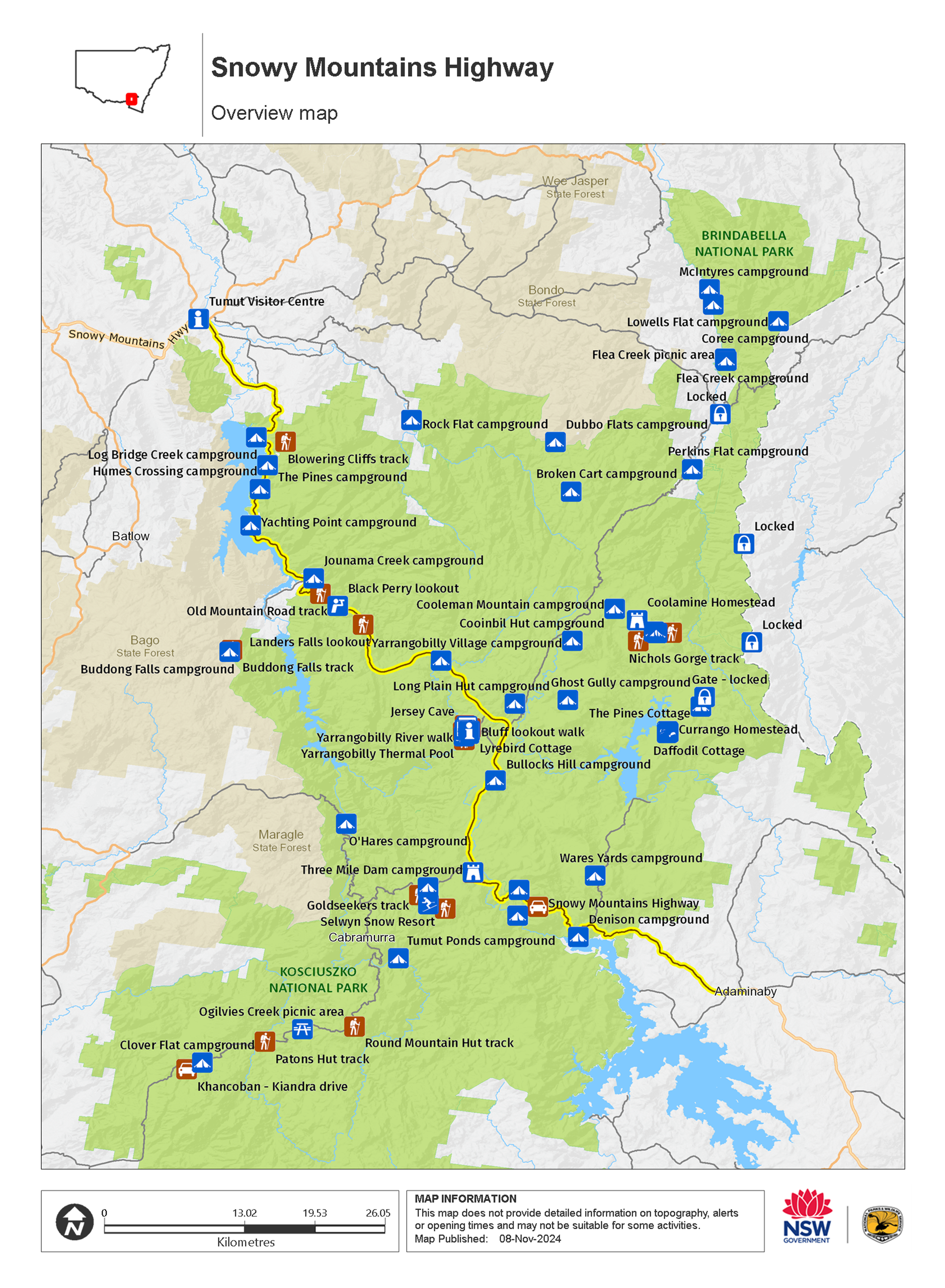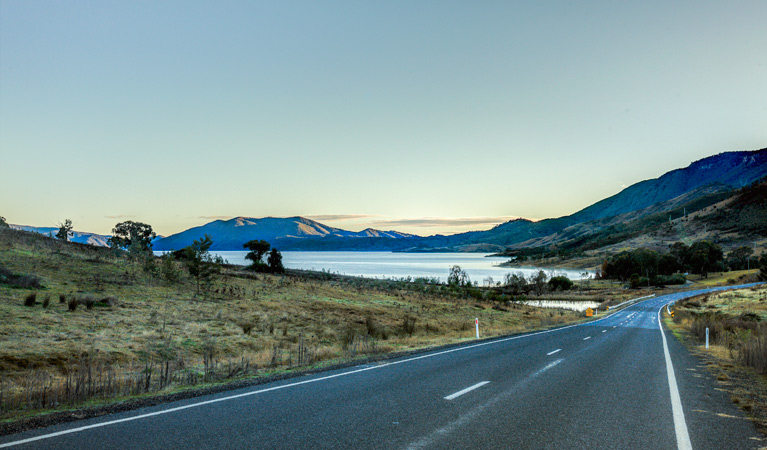Snowy Mountains Highway
Kosciuszko National Park
Overview
Snowy Mountains Highway is a scenic driving route between Tumut and Cooma, taking in caves, campgrounds, ski fields, trails for hiking, biking and horse riding in northern Kosciuszko National Park.
- Where
- Yarrangobilly area, High Plains area, Tumut area, Selwyn area in Kosciuszko National Park in Snowy Mountains
- Distance
- 129km one-way
- Time suggested
- 2hrs
- Please note
Fuel is available at Cooma, Adaminaby and Tumut. Please make sure you’ve got enough in the tank before entering the park.
Snowy Mountains Highway is not only a great driving route through Australia's high country, it's also the gateway into northern Kosciuszko National Park and the many activities this region of NSW offers. So load up your vehicle with family or friends and take a road trip to the south of the state.
Bring your walking shoes and enjoy short historic walks, or longer strolls to scenic lookouts. Guided or self-guided tours of Yarrangobilly Caves can be followed by a swim in the nearby thermal pool; there’s nothing quite like soaking in 27-degree water when there’s snow on the ground.
In summer, more trails for hiking, mountain biking and horse riding can be reached from Tantangara Road or Long Plain Road. Enjoy heritage accommodation at Currango Homestead, or head into the remote high plains to explore the gorges, walks, huts and campgrounds, such as Blue Waterholes campground.
Along the way:
-

Tumut Visitor Centre
Tumut Visitor Centre, on Snowy Mountains Highway, is the ideal starting point for a visit to northern Kosciuszko National Park, offering information, booking services, and souvenirs.
-

Black Perry lookout
Black Perry lookout, near Talbingo Mountain in Kosciuszko National Park, offers scenic views over the Snowy Mountains region, and is close to Tumut and Yarrangobilly Caves.
-

Yarrangobilly Caves Visitor Centre
Yarrangobilly Caves Visitor Centre is your one stop destination for information on cave tours and tickets, and top tips on where to stay and what to do in the Yarrangobilly and northern areas of Kosciuszko National Park.
Map

Map legend

Local alerts
For the latest updates on fires, closures and other alerts in this area, see https://uat.nswparks.cloud/things-to-do/driving-routes/snowy-mountains-highway/local-alerts
General enquiries
- National Parks Contact Centre
- 7am to 7pm daily
- 1300 072 757 (13000 PARKS) for the cost of a local call within Australia excluding mobiles
- parks.info@environment.nsw.gov.au
Park info
- in the Selwyn area of Kosciuszko National Park in the Snowy Mountains region
The Selwyn area is open all year, but some roads and trails may close due to weather conditions or park management issues. Kings Cross Road and the Khancoban-Cabramurra Road are closed in winter (June to October long weekends). Some campgrounds in the Selwyn area close in winter.
-
Park entry fees apply in winter on Link Road
June to October long weekends: $29 per vehicle per day (24hrs from purchase); motorcycles $12; bus passengers $11.45 per adult, $3.60 per child per day (24hrs). Single and Multi-Day passes available from entry stations, NPWS visitor centres, pay machines or via the Park'nPay app.
See vehicle entry fees for other areas in Kosciuszko National Park.
Buy annual pass.
- in the Tumut area of Kosciuszko National Park in the Snowy Mountains region
The Tumut area is open all year but some roads and trails may close due to weather conditions or park management issues.
-
No park entry fees apply in the Tumut area. See vehicle entry fees for other areas in Kosciuszko National Park.
Buy annual pass.
- in the Yarrangobilly area of Kosciuszko National Park in the Snowy Mountains region
The Yarrangobilly area is open all year. See individual show caves and guided tours for times and prices. Additional tours run during NSW school holidays. Contact Yarrangobilly Caves on (02) 6454 9597 to confirm the tour times for your visit.
-
Park entry fees apply in the Yarrangobilly area
$4 per vehicle per day applies at Yarrangobilly Caves for motor vehicles without a Kosciuszko National Park day pass or NPWS All Parks annual pass.
See vehicle entry fees for other areas in Kosciuszko National Park.
You’ll need to buy a ticket or cave pass from the Yarrangobilly Caves Visitor Centre to visit all Yarrangobilly’s caves.
Buy annual pass.
- in the High Plains area of Kosciuszko National Park in the Snowy Mountains region
Long Plain Road and Tantangara Road (beyond the dam wall) are closed in winter from June to October long weekends. This period may be extended so it’s a good idea to contact the Tumut Visitor Centre. Areas may have to close at times due to poor weather or fire danger.
-
No park entry fees apply in the High Plains area. See vehicle entry fees for other areas in Kosciuszko National Park.
Buy annual pass.
Visitor info
All the practical information you need to know about Snowy Mountains Highway.
Maps and downloads
Learn more
Snowy Mountains Highway is in Selwyn area. Here are just some of the reasons why this park is special:
Kiandra's claims to fame

The discovery of gold at Kiandra in 1859 attracted up to 10,000 prospectors hoping to strike it rich. Just 18 months later, after harsh winters and falling gold finds, only a few hundred gold miners remained. It's remembered as one of Australia’s shortest gold rushes, not to mention it’s highest (and coldest). In 1861, Kiandra became the birthplace of skiing in Australia, when Norwegian gold miners fashioned skis from fence palings. By the 1870s regular ski carnivals were arranged, and Australia had its first official ski slope here. Mining continued into the 1930s, with grazing and winter skiing also keeping the community alive. Before devastating fires in 2019-2020, four buildings still stood here, including Kiandra Courthouse, which had served as a courthouse, private residence, ski chalet, hotel and bar.
Plants and animals protected in this park
Animals
-

Bare-nosed wombat (Vombatus ursinus)
A large, squat marsupial, the Australian bare-nosed wombat is a burrowing mammal found in coastal forests and mountain ranges across NSW and Victoria. The only other remaining species of wombat in NSW, the endangered southern hairy-nosed wombat, was considered extinct until relatively recently.
-

Platypus (Ornithorhynchus anatinus)
One of the most fascinating and unusual Australian animals, the duck-billed platypus, along with the echidna, are the only known monotremes, or egg-laying mammals, in existence. The platypus is generally found in permanent river systems and lakes in southern and eastern NSW and east and west of the Great Dividing Range.
-

Wedge-tailed eagle (Aquila audax)
With a wingspan of up to 2.5m, the wedge-tailed eagle is Australia’s largest bird of prey. These Australian animals are found in woodlands across NSW, and have the ability to soar to heights of over 2km. If you’re bird watching, look out for the distinctive diamond-shaped tail of the eagle.
Plants
-

Billy buttons (Craspedia spp. )
Billy buttons are attractive Australian native plants that are widespread throughout eastern NSW in dry forest, grassland and alpine regions such as Kosciuszko National Park. The golden-yellow globe-shaped flowers are also known as woollyheads. Related to the daisy, billy buttons are an erect herb growing to a height of 50cm.

